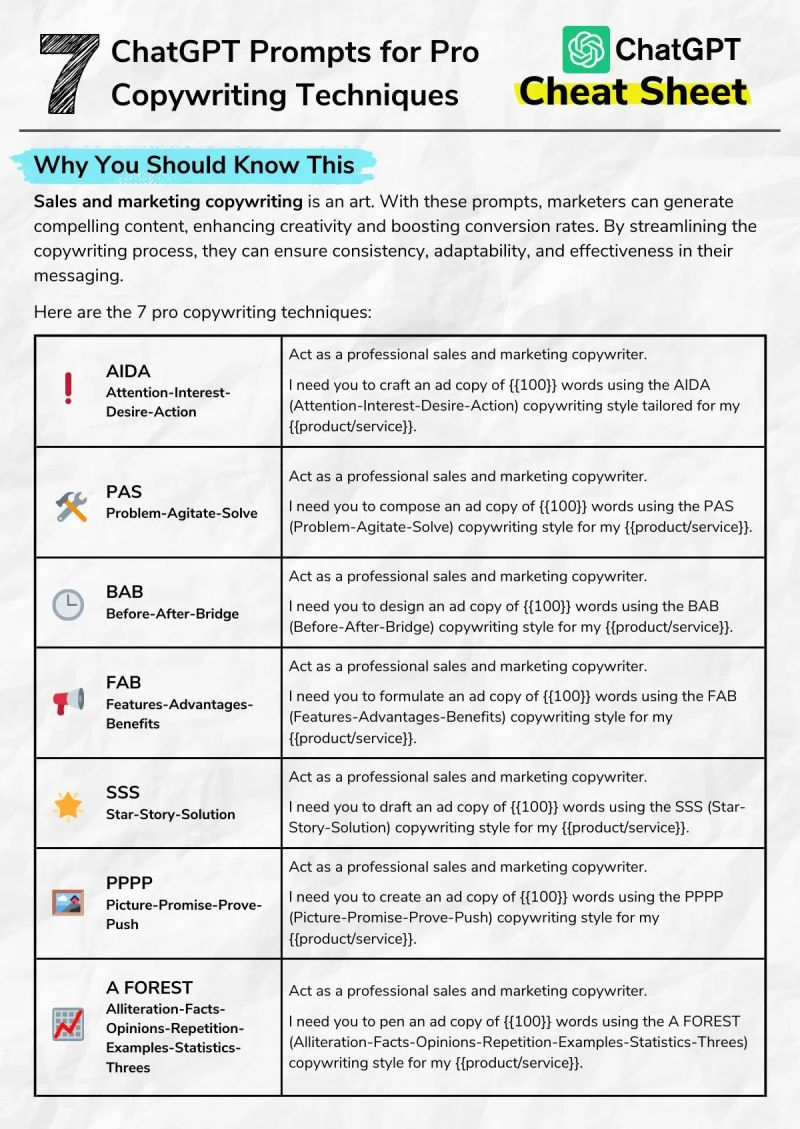Here's a list of AI and Data terms and jargons!
Great Post By: Nicolas Boucher
Original Post Below
"Save this post to learn all AI & Data terms
Everything you need to know in one page!
Is this post helpful and you learned something?
Show your appreciation by liking, commenting or reposting!
1. GPT (Generative Pre-trained Transformer)
• Definition: General-purpose language models
• Finance Use: Automated Content Generation, Customer Support Chatbots
2. NLP (Natural Language Processing)
• Definition: Enables computers to understand human language
• Finance Use: Chatbots, Fraud Detection
3. API (Application Programming Interface)
• Definition: Rules enabling software interaction
• Finance Use: Data exchange, Real-time market data, Payment Processing
4. RPA (Robotic Process Automation)
• Definition: AI automating rule-based tasks
• Finance Use: Data Entry, Invoice Processing, Account Reconciliation
5. OCR (Optical Character Recognition)
• Definition: Extracts text from images or scanned docs
• Finance Use: Automated document processing, expense management
6. ASR (Automatic Speech Recognition)
• Definition: Converts spoken language to text
• Finance Use: Transcription, Customer Service Call Analysis
7. CL (Clustering)
• Definition: Groups similar data points
• Finance Use: Market Segmentation, Fraud Detection
8. TTS (Text-to-Speech)
• Definition: Converts written text to spoken word
• Finance Use: Audio Financial Reports, Customer Notifications
9. LLM (Large Language Model)
• Definition: AI trained on vast text data
• Finance Use: Sentiment Analysis, Document Summarization
10. DL (Deep Learning)
• Definition: Specialized ML using deep neural networks
• Finance Use: Analyze market data, predict patterns
11. ML (Machine Learning)
• Definition: Enables learning from data
• Finance Use: Credit Scoring, Algorithm Trading
12. RNN (Recurrent Neural Network)
• Definition: Processes sequential data
• Finance Use: Time-Series Analysis, Stock Price Prediction
13. SVM (Support Vector Machines)
• Definition: Used for classification & regression analysis
• Finance Use: Credit Risk Assessment, Portfolio Optimization
14. KNN (K-Nearest Neighbors)
• Definition: Classifies data based on neighbors
• Finance Use: Customer Segmentation, Anomaly Detection
15. TKN (Tokenization)
• Definition: Replaces data with unique symbols
• Finance Use: Information Extraction, Sentiment Analysis
16. PCA (Principal Component Analysis)
• Definition: Reduces data dimensionality
• Finance Use: Risk Management, Feature Extraction
18. GAN (Generative Adversarial Network)
• Definition: Neural networks creating realistic data
• Finance Use: Synthetic Data Generation, Anomaly Detection
19. Naive Bayes
• Definition: Classification with predictor independence
• Finance Use: Risk Management, Customer Segmentation
20. KM (K-Means)
• Definition: Organizes data into k-clusters
______________
Great Post By: Nicolas Boucher
Original Post Below
"Save this post to learn all AI & Data terms
Everything you need to know in one page!
Is this post helpful and you learned something?
Show your appreciation by liking, commenting or reposting!
1. GPT (Generative Pre-trained Transformer)
• Definition: General-purpose language models
• Finance Use: Automated Content Generation, Customer Support Chatbots
2. NLP (Natural Language Processing)
• Definition: Enables computers to understand human language
• Finance Use: Chatbots, Fraud Detection
3. API (Application Programming Interface)
• Definition: Rules enabling software interaction
• Finance Use: Data exchange, Real-time market data, Payment Processing
4. RPA (Robotic Process Automation)
• Definition: AI automating rule-based tasks
• Finance Use: Data Entry, Invoice Processing, Account Reconciliation
5. OCR (Optical Character Recognition)
• Definition: Extracts text from images or scanned docs
• Finance Use: Automated document processing, expense management
6. ASR (Automatic Speech Recognition)
• Definition: Converts spoken language to text
• Finance Use: Transcription, Customer Service Call Analysis
7. CL (Clustering)
• Definition: Groups similar data points
• Finance Use: Market Segmentation, Fraud Detection
8. TTS (Text-to-Speech)
• Definition: Converts written text to spoken word
• Finance Use: Audio Financial Reports, Customer Notifications
9. LLM (Large Language Model)
• Definition: AI trained on vast text data
• Finance Use: Sentiment Analysis, Document Summarization
10. DL (Deep Learning)
• Definition: Specialized ML using deep neural networks
• Finance Use: Analyze market data, predict patterns
11. ML (Machine Learning)
• Definition: Enables learning from data
• Finance Use: Credit Scoring, Algorithm Trading
12. RNN (Recurrent Neural Network)
• Definition: Processes sequential data
• Finance Use: Time-Series Analysis, Stock Price Prediction
13. SVM (Support Vector Machines)
• Definition: Used for classification & regression analysis
• Finance Use: Credit Risk Assessment, Portfolio Optimization
14. KNN (K-Nearest Neighbors)
• Definition: Classifies data based on neighbors
• Finance Use: Customer Segmentation, Anomaly Detection
15. TKN (Tokenization)
• Definition: Replaces data with unique symbols
• Finance Use: Information Extraction, Sentiment Analysis
16. PCA (Principal Component Analysis)
• Definition: Reduces data dimensionality
• Finance Use: Risk Management, Feature Extraction
18. GAN (Generative Adversarial Network)
• Definition: Neural networks creating realistic data
• Finance Use: Synthetic Data Generation, Anomaly Detection
19. Naive Bayes
• Definition: Classification with predictor independence
• Finance Use: Risk Management, Customer Segmentation
20. KM (K-Means)
• Definition: Organizes data into k-clusters
______________
Here's a list of AI and Data terms and jargons!
Great Post By: Nicolas Boucher
Original Post Below
👇 👇 👇
"Save this post to learn all AI & Data terms
Everything you need to know in one page!
🙏 Is this post helpful and you learned something?
Show your appreciation by liking, commenting or reposting!
1. GPT (Generative Pre-trained Transformer)
• Definition: General-purpose language models
• Finance Use: Automated Content Generation, Customer Support Chatbots
2. NLP (Natural Language Processing)
• Definition: Enables computers to understand human language
• Finance Use: Chatbots, Fraud Detection
3. API (Application Programming Interface)
• Definition: Rules enabling software interaction
• Finance Use: Data exchange, Real-time market data, Payment Processing
4. RPA (Robotic Process Automation)
• Definition: AI automating rule-based tasks
• Finance Use: Data Entry, Invoice Processing, Account Reconciliation
5. OCR (Optical Character Recognition)
• Definition: Extracts text from images or scanned docs
• Finance Use: Automated document processing, expense management
6. ASR (Automatic Speech Recognition)
• Definition: Converts spoken language to text
• Finance Use: Transcription, Customer Service Call Analysis
7. CL (Clustering)
• Definition: Groups similar data points
• Finance Use: Market Segmentation, Fraud Detection
8. TTS (Text-to-Speech)
• Definition: Converts written text to spoken word
• Finance Use: Audio Financial Reports, Customer Notifications
9. LLM (Large Language Model)
• Definition: AI trained on vast text data
• Finance Use: Sentiment Analysis, Document Summarization
10. DL (Deep Learning)
• Definition: Specialized ML using deep neural networks
• Finance Use: Analyze market data, predict patterns
11. ML (Machine Learning)
• Definition: Enables learning from data
• Finance Use: Credit Scoring, Algorithm Trading
12. RNN (Recurrent Neural Network)
• Definition: Processes sequential data
• Finance Use: Time-Series Analysis, Stock Price Prediction
13. SVM (Support Vector Machines)
• Definition: Used for classification & regression analysis
• Finance Use: Credit Risk Assessment, Portfolio Optimization
14. KNN (K-Nearest Neighbors)
• Definition: Classifies data based on neighbors
• Finance Use: Customer Segmentation, Anomaly Detection
15. TKN (Tokenization)
• Definition: Replaces data with unique symbols
• Finance Use: Information Extraction, Sentiment Analysis
16. PCA (Principal Component Analysis)
• Definition: Reduces data dimensionality
• Finance Use: Risk Management, Feature Extraction
18. GAN (Generative Adversarial Network)
• Definition: Neural networks creating realistic data
• Finance Use: Synthetic Data Generation, Anomaly Detection
19. Naive Bayes
• Definition: Classification with predictor independence
• Finance Use: Risk Management, Customer Segmentation
20. KM (K-Means)
• Definition: Organizes data into k-clusters
______________
0 Comentários
0 Compartilhamentos
39 Visualizações
0 Anterior








